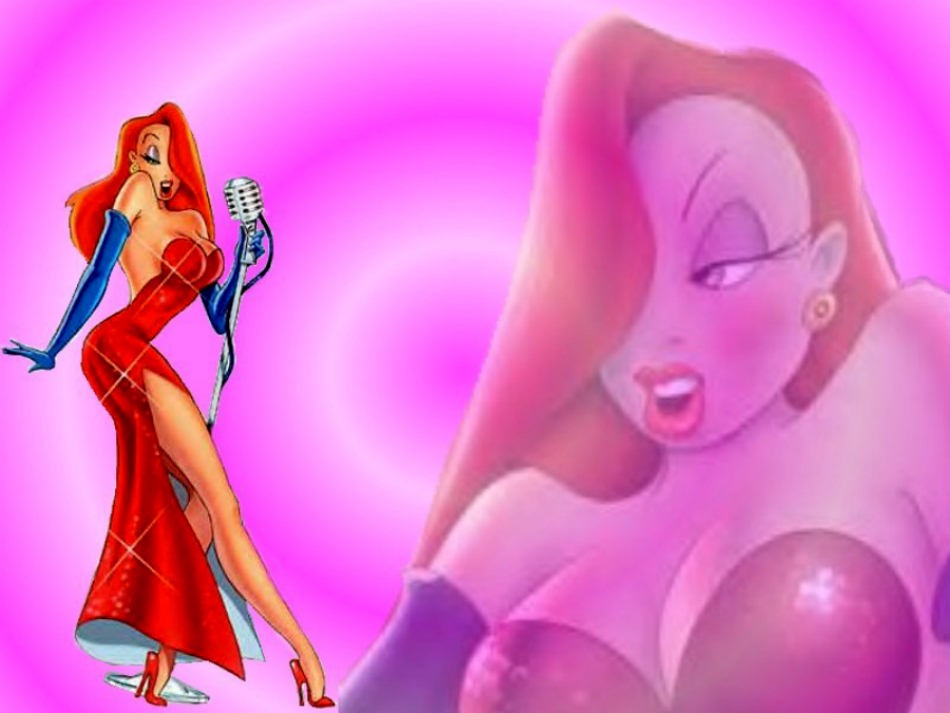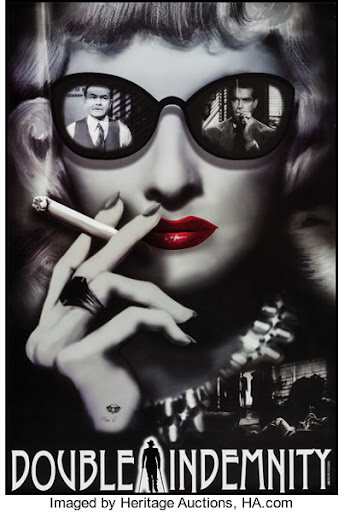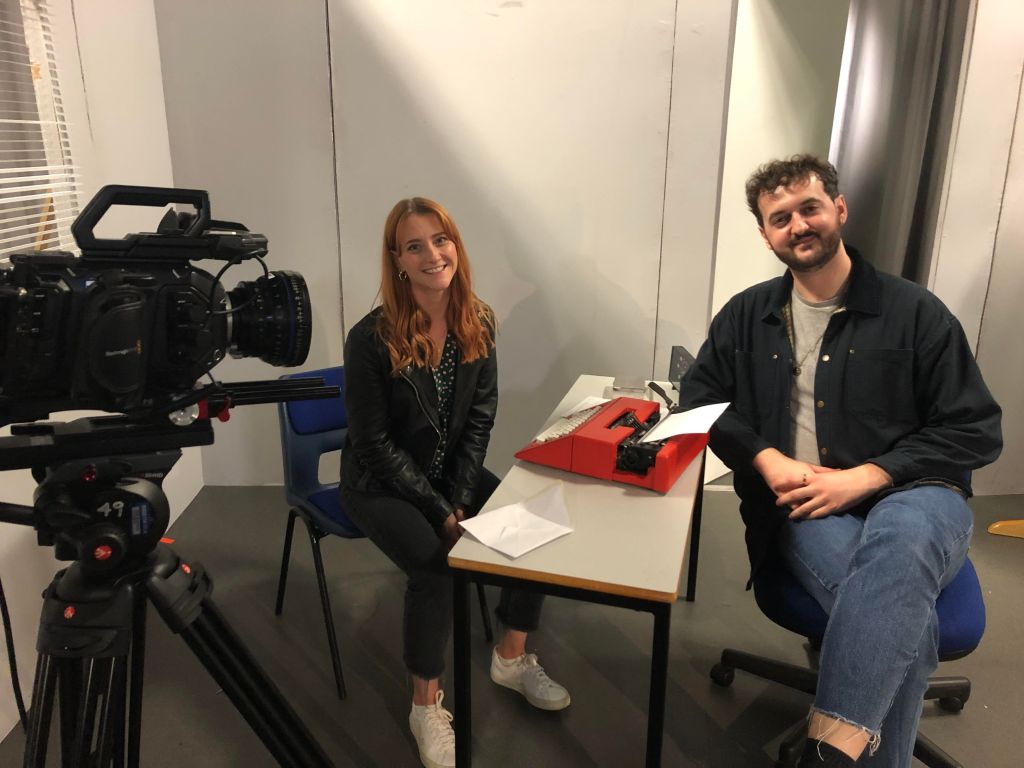
This blog post is highlighting my research area of WOMEN IN FILM. For this blog post, I will be looking at the character archetype of the Film Noir Femme Fatale. First, I will be reflecting upon what makes a Femme Fatale and how she plays an integral role within the Film Noir genre. Secondly, I will be looking at small case studies and examples of Femme Fatales. Lastly, this blog post will end with a personal reflection of two films during my Bachelor’s degree and my Master’s degree which have involved the character archetype of the Femme Fatale.

What is a “FEMME FATALE”?
‘‘From the French for “fatal woman”, a female character who uses her beauty to lure and entrap men leading to their downfall and, usually death’ (Blandford et al, 2001:95-6)’ (Neale, 2010:187)
The character archetype of the Femme Fatale is ‘a defining ingredient of noir’ (Neale, 2010:188) and fulfils an important role in the deception and manipulation of the male protagonist. Bronfen comments on how Paula Rabinwitz describes the Femme Fatale as a ‘“false… double-crosser”’ (2004:106) who will never get what SHE truly desires and ends with tragedy. Julie Grossman – who has come up multiple times during my research of the Femme Fatale – states that the character archetype is often misunderstood an in fact ‘film noir’s actual femmes fatales, [are] evil women whose raison d’etre is to murder and deceive’ (2007:19).
Brofen describes the genre of Film Noir ‘as a “male fantasy”’ (2004:113) and the character archetype of the ‘femme fatale, as the mythic “dark lady, the spider woman, the evil seductress who tempts man and brings about his destruction”’ (2004:113).

Mini Case Studies:
I have chosen four Femme Fatales to do Mini Case Studies of:
Double Indemnity (1944) – Phyllis Dietrichson
My first Film Noir film was Double Indemnity (1944) – however I had seen several Femme Fatales before viewing my first Noir film. I believe that Phyllis Dietrichson embodies the key characteristics of what a Femme Fatale must be – she is a seductive sexual villain who is also vulnerable but manipulative and opportunistic. Steve Neale (in his chapter featuring discussions of two different femme fatales) commented that the character archetype of the Femme Fatale ‘has been applied more appropriately to the character of Phyllis Dietrichson’ (2010:188) than many other femme fatales in films that supposedly are named as noir films. Neale makes an important note that some femme fatales are labelled as such but do not exhibit the correct characteristics and feeling of a true femme fatale as with Phyllis Dietrichson in Double Indemnity (1944).

Who Framed Roger Rabbit? (1988) – Jessica Rabbit
In Who Framed Roger Rabbit? (1988), Jessica Rabbit, the wife of Roger Rabbit, is a very sexualised animated character who evokes the beauty and desire of a Femme Fatale. Demonstrated throughout the film, Jessica Rabbit as a Femme Fatale is ‘a symptom of patriarchal anxiety about feminism’ (Bronfen, 2004:115). Jessica Rabbit ‘manipulat[ed] the outcome of their fatal meeting’ (Bronfen, 2004:106) (Pictured in Figure 5). She completely and utterly dominates the scene and the male protagonist who like many noir protagonists is a detective. Even as a “Toon” and not a human actress she is a seductress and entices the audience as a Femme Fatale.

Batman and Robin (1997) – Poison Ivy
Personally, Poison Ivy is one of my favourite Femme Fatales out of all the mini case studies and I love the way Uma Thurman portrayed the character in Batman and Robin (1997) (pictured below in Figure 6). Manipulation is a major part of the character’s ability to control others – especially men. Much like other Femme Fatales, Poison Ivy ‘‘beauty’ plays a part’ (Neale, 2010:187) in contributing to her character – but the character of Ivy only believes this has happened and feels able to begin her true work once she transforms into the villainous Poison Ivy.

Basic Instinct (1992) – Catherine Tramell
Sharon Stone’s character of Catherine Tramell in Basic Instinct (1992) has probably one of the most provocative and famous Femme Fatale scenes (pictured below in Figure 7) – I find when people talk about this scene, they forget what actually happens within the scene rather remembering Sharon Stone and her legs. She is seen as a ‘figure of male fantasy, articulating both a fascination for the sexually aggressive woman, as well as anxieties about feminine domination’ (Bronfen, 2004:106).

Personal Reflection 1: Bachelor’s Second Year Short Film ‘Femme Fatale’
A few years ago, during my bachelor’s, I wrote, produced and directed a short film (3-5 minutes long) titled ‘Femme Fatale’ featuring my version of a modern-day Femme Fatale who hunts down sexual predators and started off in a church (the beautiful Church in Old Hatfield right by the University which actually appeared in The Favourite (2018)), she then killed the man and ends with her going back home and crossing a name off a long list.

Coincidentally, I worked in a film crew entirely made of women and all of us discussed how much we felt this topic would need to be done respectfully and took precautions with the way we presented the idea. Interestingly, in 2020 once the majority of the other crew members had graduated (I did an additional year in my third year), we all watched Promising Young Woman (2020) which featured a similar topic and we were glad to see a feature-length Hollywood film receive great reviews and even won the Academy Award for Best Original Screenplay. As women who have entered the film industry (and myself who is continuing into further education within the film sector), we all found that films that speak out about important topics – especially since the rise of the #MeToo Movement.
Personal Reflection 2: Master’s Film Noir Scene ‘Otis and Smith’
In this past semester, we have had the opportunity to explore different genres and themes on Wednesday mornings and in the afternoon on Wednesdays, we would write a short scene and film it in the studio – basically making a scene from scratch to finishing film in just a few hours. These quick high-intensity opportunities we had this semester have been absolutely amazing and I have enjoyed every second of it. We made four scenes in total: 1) Drama Dialogue from scene from What’s up, Doc? (1972), 2) Film Noir featuring detective as a woman instead of a man, 3) Science Fiction Airlock scene with sliding door, and 4) A Horror and Isolation scene depicting the importance of space (only set decoration was a sofa).

For this personal reflection, I will be commenting on the second scene we filmed: Film Noir. For this scene, I wrote the scene and was the 1st AD (1st Assistant Director) – I wrote the scene in 20 minutes which I never thought I would be able to do in my life! But under extreme time limits and pressure, the adrenaline rush was amazing. For this scene, we were specifically told that the normal stereotype of the male detective had to change to the woman – making the FEMME FATALE the Detective. For this scene in particular, I decided dialogue was mostly going to be from the man’s side and the reaction shots with the female detective and the Film Noir lighting from the Venetian blinds. The element of the Femme Fatale was subverted and this is something I really enjoyed about these amazing filming opportunities is that we could write and make scenes which portray ideas that we want to reflect – and the thing I want to do more than anything is to subvert expectations and subvert ideas of stereotypes (much like a few of my previous reflective blog posts – e.g., Ellen Ripley and Sarah Connor, Terrorism in Cinema and Kathryn Bigelow).
Bibliography:
BRONFEN, E. (2004). ‘Femme Fatale – Negotiations of Tragic Desire’. New Literary History. [Online] 35(1) pp.103-116. Available from: https://www.proquest.com/docview/221368118/fulltextPDF/E0132FBD662444ABPQ/1?accountid=14660 [Accessed: 19th December 2021]
GROSSMAN, J. (2007). ‘Film Noir’s “Femme Fatales”Hard-Boiled Women: Moving Beyond Gender Fantasies’. Quarterly Review of Film and Video. [Online] 24(1) pp. 19-30. Available from: https://www-tandfonline-com.ezproxy.herts.ac.uk/doi/pdf/10.1080/10509200500485983?needAccess=true [Accessed: 27th December 2021]
GROSSMAN, J. (2010). ‘Well, Aren’t We Ambitious’, or ‘You’ve Made up Your Mind I’m Guilty’: Reading Women as Wicked in American Film Noir. In: HANSON, H. & O’RAWE, C. (eds). The Femme Fatale: Images, History, Contexts. UK: Palgrave Macmillian UK.
NEALE, S. (2010). ‘I Can’t Tell Anymore Whether You’re Lying’: Double Indemnity, Human Desire and the Narratology of Femmes Fatales. In: HANSON, H. & O’RAWE, C. (eds). The Femme Fatale: Images, History, Contexts. UK: Palgrave Macmillian UK.
Filmography:
Batman & Robin. (1997). Film. Directed by Joel Schumacher. [DVD] US: Warner Bros.
Basic Instinct. (1992). Film. Directed by Paul Verhoeven. [DVD] US: TriStar Pictures.
Double Indemnity. (1944). Film. Directed by Billy Wilder. [DVD] US: Paramount Pictures.
Promising Young Woman. (2020). Film. Directed by Emerald Fennell. [DVD] US: Focus Features.
The Favourite. (2018). Film. Directed by Yorgos Lathimos. [DVD] UK: Fox Searchlight Pictures.
Who Framed Roger Rabbit. (1988). Film. Directed by Robert Zemeckis. [DVD] US: Buena Vista Pictures.
Illustrations:
Figure 1: Jessica Rabbit
Figure 2: Femme Fatale
Figure 3:
Figure 4: Double Indemnity
Figure 5: Jessica Rabbit
Figure 6: Poison Ivy
Figure 7: Sharon Stone
Figure 8: Church
Figure 9: My Photo that I took